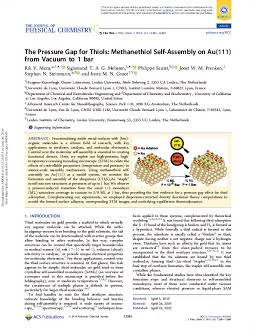2019-04-25
The Pressure Gap for Thiols: Methanethiol Self-Assembly on Au(111) from Vacuum to 1 bar
Publication
Publication
J. Phys. Chem. C , Volume 123 - Issue 19 p. 12382- 12389
Functionalizing noble metal surfaces with (bio)organic molecules is a vibrant field of research, with key applications in medicine, catalysis, and molecular electronics. Control over the molecular self-assembly is essential to creating functional devices. Here, we exploit our high-pressure, high-temperature scanning tunneling microscope (STM) to relate the effects of controllable parameters (temperature and pressure) to atomic-scale assembly mechanisms. Using methanethiol self-assembly on Au(111) as a model system, we monitor the formation and assembly of the ubiquitous (CH3S)2Au “staple” motif into row structures at pressures of up to 1 bar. We observe a pressure-induced transition from the usual 1/3 monolayer (ML) saturation coverage in vacuum to 3/8 ML at 1 bar, thus providing the first evidence for a pressure gap effect for thiol adsorption. Complementing our experiments, we employed dispersion-corrected density functional theory computations to model the formed surface adlayers, corresponding STM images, and underlying equilibrium thermodynamics.
| Additional Metadata | |
|---|---|
| I.M.N. Groot (Irene) | |
| ACS | |
| doi.org/10.1021/acs.jpcc.9b03045 | |
| J. Phys. Chem. C | |
| Organisation | Nanolayers-Former Group |
|
Mom, R., Melissen, S., Sautet, P., Frenken, J., & Steinmann, S. (2019). The Pressure Gap for Thiols: Methanethiol Self-Assembly on Au(111) from Vacuum to 1 bar. J. Phys. Chem. C, 123(19), 12382–12389. doi:10.1021/acs.jpcc.9b03045 |
|

